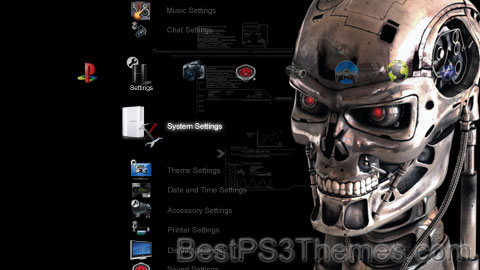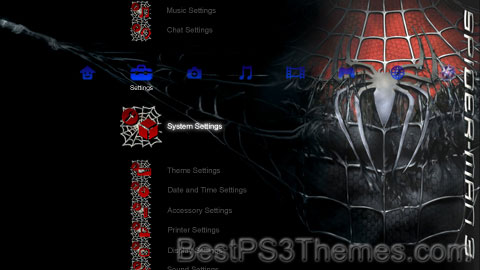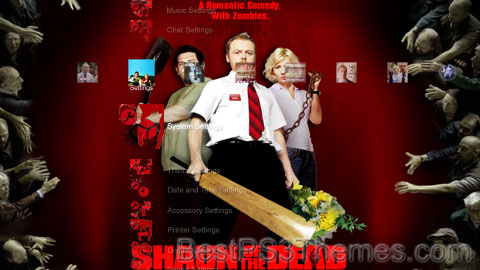V for Vendetta theme by ZHero
Download: VforVendetta.p3t

(9 backgrounds)
| V for Vendetta | |
|---|---|
 V for Vendetta collected edition cover art by David Lloyd | |
| Publisher | United Kingdom Quality Communications United States Vertigo (DC Comics) France Delcourt Brazil Abril Jovem Panini Comics |
| Creative team | |
| Writer | Alan Moore |
| Artists | |
| Letterer | Steve Craddock |
| Colourist | Steve Whitaker Siobhan Dodds David Lloyd |
| Editors |
|
| Original publication | |
| Issues | 10 |
| Date of publication | March 1982 – May 1989 |
| ISBN | 0-930289-52-8 |
V for Vendetta is a British graphic novel written by Alan Moore and illustrated by David Lloyd (with additional art by Tony Weare). Initially published between 1982 and 1985 in black and white as an ongoing serial in the British anthology Warrior, its serialization was completed in 1988–89 in a ten-issue colour limited series published by DC Comics in the United States. Subsequent collected editions were typically published under DC's specialized imprint, Vertigo, until that label was shut down in 2018. Since then it has been transferred to DC Black Label. The story depicts a dystopian and post-apocalyptic near-future history version of the United Kingdom in the 1990s, preceded by a nuclear war in the 1980s that devastated most of the rest of the world. The Nordic supremacist,[1] neo-fascist,[2][3][4][5] outwardly Christofascistic, and homophobic fictional Norsefire political party has exterminated its opponents in concentration camps, and now rules the country as a police state.
The comics follow the story's title character and protagonist, V, an anarchist revolutionary dressed in a Guy Fawkes mask, as he begins an elaborate and theatrical revolutionist campaign to kill his former captors, bring down the fascist state, and convince the people to abandon fascism in favour of anarchy, while inspiring a young woman, Evey Hammond, to be his protégée.
DC Comics sold more than 500,000 copies of the graphic novel in the United States by 2006.[6] Warner Bros. released a film adaptation of the same name, written and co-produced by the Wachowskis,[a] in 2005. Following the first and second season premieres of Gotham prequel television series Pennyworth in 2019 and 2020, showrunners Danny Cannon and Bruno Heller confirmed the series would also serve as a prequel to V for Vendetta,[7] with the series' British Civil War eventually giving way to the Norsefire government and rise of V,[8][9][10] and the third season featuring predecessors to V wearing Guy Fawkes masks.[11]
Publication history[edit]
| Book | Chapter | Warrior | DC[b] |
|---|---|---|---|
| 1: Europe After the Reign | 1: The Villain | #1 Mar 1982 |
#1 Sep 1988 |
| 2: The Voice | #2 Apr 1982 | ||
| 3: Victims | #3 Jul 1982 | ||
| 4: Vaudeville | #4 Jul 1982 | ||
| 5: Versions | #5[c] Sep 1982 |
#2 Oct 1988 | |
| 6: The Vision | #6 Oct 1982 | ||
| 7: Virtue Victorious | #7 Nov 1982 | ||
| 8: The Valley | #8 Dec 1982 | ||
| 9: Violence | #9 Jan 1983 |
#3 Nov 1988 | |
| 10: Venom | #10 Apr 1983 | ||
| 11: The Vortex | #11 Jul 1983 | ||
| 2: This Vicious Cabaret | Prelude | #12 Aug 1983 |
#4 Dec 1988 |
| 1: The Vanishing | #13 Sep 1983 | ||
| 2: The Veil | #14 Oct 1983 | ||
| 3: Video | #15 Nov 1983 | ||
| 4: A Vocational Viewpoint | #16 Dec 1983 |
#5 Dec 1988 | |
| 5: The Vacation | #18[d] Apr 1984 | ||
| 6: Variety | #19 Jun 1984 | ||
| 7: Visitors | #21[e] Aug 1984 | ||
| 8: Vengeance | #22 Sep 1984 |
#6 Dec 1988 | |
| 9: Vicissitude | #23 Oct 1984 | ||
| 10: Vermin | #24 Nov 1984 | ||
| 11: Valerie | #25 Dec 1984 | ||
| 12: The Verdict | #26 Feb 1985 |
#7[f] Jan 1989 | |
| 13: Values | #27 (unpublished) | ||
| 14: Vignettes | #28 (unpublished) | ||
| 3: The Land of Do-As-You-Please | Prologue | — | #8 Feb 1989 |
| 1: Vox Populi | |||
| 2: Verwirrung | |||
| 3: Various Valentines | |||
| 4: Vestiges | #9 Mar 1989 | ||
| V: The Valediction | |||
| 6: Vectors | |||
| 7: Vindication | |||
| 8: Vultures | #10 May 1989 | ||
| 9: The Vigil | |||
| 10: The Volcano | |||
| 11: Valhalla | |||
Notes
| |||
The first episodes of V for Vendetta appeared in black-and-white between 1982 and 1985, in Warrior, a British anthology comic published by Quality Communications. The strip was one of the least popular in that title; editor/publisher Dez Skinn remarked, "If I'd have given each character their own title, the failures would have certainly outweighed the successes, with the uncompromising 'V for Vendetta' probably being an early casualty. But with five or six strips an issue, regular [readers] only needed two or three favorites to justify their buying the title."[12]
When the publishers cancelled Warrior in 1985 (with two completed issues unpublished due to the cancellation), several companies attempted to convince Moore and Lloyd to let them publish and complete the story. In 1988, DC Comics published a ten-issue series that reprinted the Warrior stories in colour, then continued the series to completion. The first new material appeared in issue No. 7, which included the unpublished episodes that would have appeared in Warrior No. 27 and No. 28. Tony Weare drew one chapter ("Vincent") and contributed additional art to two others ("Valerie" and "The Vacation"); Steve Whitaker and Siobhan Dodds worked as colourists on the entire series.
Collected editions[edit]
The entire series has appeared collected in paperback (ISBN 0-446-39190-5) and hardback (ISBN 1-4012-0792-8) form, including Moore's "Behind the Painted Smile" essay and two "interludes" outside the central continuity. Later collections include reissued paperbacks, published in the US by DC's Vertigo imprint (ISBN 0-930289-52-8) and in the UK by Titan Books (ISBN 1-85286-291-2). A new hardback edition was published in 2005 featuring improved printing and coloring.[13] In August 2009 DC published a slipcased Absolute Edition (ISBN 1-4012-2361-3); this includes newly coloured "silent art" pages (full-page panels containing no dialogue) from the series' original run, which have not previously appeared in any previous collected edition.[13]
- — — (24 October 2008). V for Vendetta (New TPB ed.). DC Vertigo. ISBN 9781401208417. Archived from the original on 29 October 2018. Retrieved 29 October 2018.
- — — (24 December 2008). V for Vendetta (New ed.). DC Vertigo. Archived from the original on 30 October 2018. Retrieved 29 October 2018.
- — — (8 September 2009). V for Vendetta (Absolute ed.). DC Vertigo. ISBN 9781401223618. Archived from the original on 30 October 2018. Retrieved 29 October 2018.
- — — (9 October 2012). V for Vendetta (Deluxe Collector Set ed.). DC Vertigo. ISBN 9781401238582.
- — — (20 November 2018). V for Vendetta (The 30th Anniversary Deluxe ed.). DC Vertigo. ISBN 9781401285005.
Background[edit]
David Lloyd's paintings for V for Vendetta in Warrior first appeared in black and white.[14]

In writing V for Vendetta, Moore drew upon a comic strip idea submission that the DC Thomson scriptwriting competition rejected in 1975: "The Doll", which involved a transgender terrorist in white face makeup, who fought a totalitarian state during the 1980s.[15]
Years later, Skinn reportedly invited Moore to create a dark mystery strip with artist David Lloyd.[16] V for Vendetta was intended to recreate something similar to their popular Marvel UK Night Raven strip in a 1930s noir.[17] They chose against doing historical research and instead set the story in the near future rather than the recent past.[18]
Then V for Vendetta emerged, putting the emphasis on "V" rather than "Vendetta". David Lloyd developed the idea of dressing V as Guy Fawkes[19] after previous designs followed the conventional superhero look. During the preparation of the story, Moore made a list of what he wanted to bring into the plot, which he reproduced in "Behind the Painted Smile":
Orwell. Huxley. Thomas Disch. Judge Dredd. Harlan Ellison's "Repent, Harlequin!" Said the Ticktockman, Catman and The Prowler in the City at the Edge of the World by the same author. Vincent Price's Dr. Phibes and Theatre of Blood. David Bowie. The Shadow. Night Raven. Batman. Fahrenheit 451. The writings of the New Worlds school of science fiction. Max Ernst's painting "Europe After the Rain". Thomas Pynchon. The atmosphere of British Second World War films. The Prisoner. Robin Hood. Dick Turpin...[20]
The influence of such a wide number of references has been thoroughly demonstrated in academic studies,[21] above which dystopian elements stand out, especially the similarity with George Orwell's Nineteen Eighty-Four in several stages of the plot.[22]
The political climate of Britain in the early 1980s also influenced the work,[23] with Moore positing that Margaret Thatcher's Conservative government would "obviously lose the 1983 elections", and that an incoming Michael Foot-led Labour government, committed to complete nuclear disarmament, would allow the United Kingdom to escape relatively unscathed after a limited nuclear war. However, Moore felt that fascists would quickly subvert a post-nuclear holocaust Britain.[20] V, an anarchist, initially tortures and murders members of the fascist government, but as the story develops, Moore deliberately made V's actions "very, very morally ambiguous" with the aim that "I didn't want to tell people what to think, I just wanted to tell people to think."[17] The Guy Fawkes analogy was deliberate, with Moore pointing out in a 2012 interview that Britain has a history of "making heroes out of criminals or people who in other centuries might have been regarded as terrorists", desiring a similar ambiguity for a protagonist reviled as a villain by the Britain of his fictional 1990s.[24]
Moore's scenario remains untested. Addressing historical developments when DC reissued the work, he noted:
Naïveté can also be detected in my supposition that it would take something as melodramatic as a near-miss nuclear conflict to nudge Britain towards fascism... The simple fact that much of the historical background of the story proceeds from a predicted Conservative defeat in the 1983 General Election should tell you how reliable we were in our roles as Cassandras.[25]
Plot[edit]
Book 1: Europe After the Reign[edit]
On Guy Fawkes Night in London in 1997, a financially desperate 16-year-old, Evey Hammond, sexually solicits men who are actually members of the state secret police, called "The Finger". Preparing to rape and kill her, the Fingermen are dispatched by V, a cloaked anarchist wearing a mask, who later remotely detonates explosives at the Palace of Westminster before bringing Evey to his contraband-filled underground lair, the "Shadow Gallery." Evey tells V her life story, which reveals her own past and England's recent history. During a dispute over Poland in the late 1980s, the Soviet Union and the United States, under the presidency of Ted Kennedy, entered a global nuclear war which left continental Europe and Africa uninhabitable. Although Britain itself was not bombed due to the Labour government's decision to remove American nuclear missiles, it faced environmental devastation and famine due to the nuclear winter. After a period of lawlessness in which Evey's mother died, the remaining corporations and fascist groups took over England and formed a new totalitarian government, Norsefire. Evey's father, a former socialist, was arrested by the regime.
Meanwhile, Eric Finch, a veteran detective in charge of the regular police force ("The Nose"), begins investigating V's terrorist activities. Finch often communicates with the other top government officials, collectively known as "The Head." These individuals include Derek Almond, who supervises the Finger, and Adam Susan, the reclusive Leader of Norsefire, who obsessively oversees the government's Fate computer system. Finch's case thickens when V kidnaps Lewis Prothero, a propaganda-broadcasting radio personality, and drives him into a mental breakdown by forcing him to relive his actions as the commander of a "resettlement" camp near Larkhill with his treasured doll collection as inmates. Evey agrees to help V with his next assassination by disguising herself as a child prostitute to infiltrate the home of Bishop Anthony Lilliman, a paedophile priest, whom V forces to commit suicide by eating a poisoned communion wafer. He prepares to murder Dr. Delia Surridge, a medical researcher who once had a romance with Finch. Finch suddenly discovers the connection among V's three targets: they all used to work at Larkhill. That night, V kills both Almond and Surridge. Surridge leaves a diary revealing that V—a former inmate and victim of Surridge's cruel medical experiments—destroyed and fled the camp and is now eliminating the camp's former officers for what they did. Finch reports these findings to Susan, and suspects that this vendetta may actually be a cover for V, who, he worries, may be plotting an even bigger terrorist attack.
Book 2: This Vicious Cabaret[edit]
Four months later, V breaks into Jordan Tower, the home of Norsefire's propaganda department, "the Mouth"—led by Roger Dascombe—to broadcast a speech that calls on the people to resist the government. V escapes using an elaborate diversion that results in Dascombe's death. Finch is soon introduced to Peter Creedy, the Finger's new head, who provokes Finch to strike him and thus get sent on a forced vacation. Evey takes shelter at the house of a man named Gordon, who found her on the street. While originally platonic, they eventually build a romantic relationship. Evey and Gordon unknowingly cross paths with Rose Almond, the widow of the recently killed Derek. After Derek's death, Rose had reluctantly begun a relationship with Dascombe. With both of her lovers murdered, she is forced to perform demoralizing burlesque work, increasing her hatred of the unsupportive government.
When a Scottish gangster named Ally Harper murders Gordon, a vengeful Evey interrupts a meeting between Harper and Creedy, the latter of whom is buying the support of Harper's thugs in preparation for a coup d'état. Evey attempts to shoot Harper but is suddenly abducted and then imprisoned. Amidst interrogation and torture, Evey finds an old letter hidden in her cell by an inmate named Valerie Page, a film actress who was imprisoned and executed for being a lesbian and documented her experiences in the letter.
Evey's interrogator finally gives her a choice of collaboration or death; inspired by Valerie's letter, Evey refuses to collaborate and, expecting to be executed, is instead told that she is free. Stunned, Evey learns that her supposed imprisonment is a hoax constructed by V so that she could experience an ordeal similar to the one that shaped him at Larkhill. He reveals that Valerie was a real Larkhill prisoner who died in the cell next to his and that the letter is not a fake. Evey forgives V, who has hacked into the government's Fate computer system and started emotionally manipulating Adam Susan with mind games. Consequently, Susan, who has formed a bizarre romantic attachment to the computer, begins to descend into madness.
Book 3: The Land of Do-As-You-Please[edit]
The following 5 November (1998), V blows up the Post Office Tower and Jordan Tower, killing "the Ear" leader Brian Etheridge, in addition to effectively shutting down three government agencies: the Eye, the Ear, and the Mouth. Creedy's men and Harper's associated street gangs violently suppress the subsequent wave of revolutionary fervor from the public. V notes to Evey that he has not yet achieved what he calls the "Land of Do-as-You-Please," meaning a functional anarchistic society, and considers the current chaotic situation an interim period of "Land of Take-What-You-Want." Finch has been mysteriously absent, and his young assistant, Dominic Stone, one day realises that V has been influencing the Fate computer all along, which explained V's consistent foresight. All the while, Finch has been traveling to the abandoned site of Larkhill, where he takes LSD to conjure up memories of his own devastating past and to put his mind in the role of a prisoner of Larkhill, like V, to help give him an intuitive understanding of V's experiences. Returning to London, Finch suddenly deduces that V's lair is inside the abandoned Victoria Station, which he enters.
V takes Finch by surprise, resulting in a scuffle that sees Finch shoot V, and V wounds Finch with a knife. V claims that he cannot be killed since he is only an idea and that "ideas are bulletproof"; regardless, V is indeed mortally wounded and returns to the Shadow Gallery deeper within, dying in Evey's arms. Evey considers unmasking V but decides not to, realizing that V is not an identity but a symbol. She then assumes V's identity, donning one of his spare costumes. Finch sees the large amount of blood that V has left in his wake and deduces that he has mortally wounded V. Occurring concurrently to this, Creedy has been pressuring Susan to appear in public, hoping to leave him exposed. Sure enough, as Susan stops to shake hands with Rose during a parade, she shoots him in the head in vengeance for the death of her husband and the life she has had to lead since then. Following Rose's arrest, Creedy assumes emergency leadership of the country, and Finch emerges from the subway proclaiming V's death.
Due to his LSD-induced epiphany, Finch leaves his position within "the Nose." The power struggle between the remaining leaders results in all of their deaths: Harper betrays and kills Creedy at the behest of Helen Heyer (wife of "the Eye" leader Conrad Heyer, who had outbid Creedy for Harper's loyalty), and Harper and Conrad Heyer kill each other during a fight precipitated by Heyer's discovery that his wife Helen had had an affair with Harper.
With the fate of the top government officials unknown to the public, Stone acts as leader of the police forces deployed to ensure that the riots are contained should V remain alive and make his promised public announcement. Evey appears to a crowd, dressed as V, announcing the destruction of 10 Downing Street the following day and telling the crowd they must "...choose what comes next. Lives of your own, or a return to chains", whereupon a general insurrection begins. Evey destroys 10 Downing Street[26] by blowing up an Underground train containing V's body, in the style of an explosive Viking funeral. She abducts Stone, apparently to train him as her successor to make sure people like Susan will never hold power ever again. The book ends with Finch quietly observing the chaos raging in the city and walking down an abandoned motorway whose lights have all gone out.
Norsefire government[edit]
The highest-level officials in the Norsefire government form a council known as "The Head." The five individual departments are named after sensory organs or appendages that reference their functions.
| Branch | Head | Eye | Ear | Nose | Finger | Mouth
Futurama iPod – Unofficial v2.1Futurama iPod – Unofficial v2.1 theme by crazEyez Download: FuturamaiPodv2.1.p3t
P3T Unpacker v0.12 This program unpacks Playstation 3 Theme files (.p3t) so that you can touch-up an existing theme to your likings or use a certain wallpaper from it (as many themes have multiple). But remember, if you use content from another theme and release it, be sure to give credit! Download for Windows: p3textractor.zip Instructions: Download p3textractor.zip from above. Extract the files to a folder with a program such as WinZip or WinRAR. Now there are multiple ways to extract the theme. The first way is to simply open the p3t file with p3textractor.exe. If you don’t know how to do this, right click the p3t file and select Open With. Alternatively, open the p3t file and it will ask you to select a program to open with. Click Browse and find p3textractor.exe from where you previously extracted it to. It will open CMD and extract the theme to extracted.[filename]. After that, all you need to do for any future p3t files is open them and it will extract. The second way is very simple. Just drag the p3t file to p3textractor.exe. It will open CMD and extract the theme to extracted.[filename]. For the third way, first put the p3t file you want to extract into the same folder as p3textractor.exe. Open CMD and browse to the folder with p3extractor.exe. Enter the following: Terminator #2 (2.42 3D Icons)Terminator theme by NIHAT Download: Terminator_2.p3t
Look up terminator in Wiktionary, the free dictionary. Terminator may refer to: Science and technology[edit]Genetics[edit]
Astronomy[edit]
Electronics and computers[edit]
Military[edit]
Entertainment[edit]Films and television[edit]
Literature[edit]
Music[edit]
Games[edit]
Comics[edit]
Other entertainment[edit]
People[edit]
Other uses[edit]
See also[edit]Spiderman TrilogyThe Simpsons #8The Simpsons theme by Yvon12 Download: Simpsons_8.p3t
The Simpsons is an American animated sitcom created by Matt Groening for the Fox Broadcasting Company.[1][2][3] Developed by Groening, James L. Brooks, and Sam Simon, the series is a satirical depiction of American life, epitomized by the Simpson family, which consists of Homer, Marge, Bart, Lisa, and Maggie. Set in the fictional town of Springfield, it caricatures society, Western culture, television, and the human condition. The family was conceived by Groening shortly before a solicitation for a series of animated shorts with producer Brooks. He created a dysfunctional family and named the characters after his own family members, substituting Bart for his own name; he thought Simpson was a funny name in that it sounded similar to "simpleton".[4] The shorts became a part of The Tracey Ullman Show on April 19, 1987. After three seasons, the sketch was developed into a half-hour prime time show and became Fox's first series to land in the Top 30 ratings in a season (1989–1990). Since its debut on December 17, 1989, 768 episodes of the show have been broadcast. It is the longest-running American animated series, longest-running American sitcom, and the longest-running American scripted primetime television series, both in seasons and individual episodes. A feature-length film, The Simpsons Movie, was released in theaters worldwide on July 27, 2007, to critical and commercial success, with a sequel in development as of 2018. The series has also spawned numerous comic book series, video games, books, and other related media, as well as a billion-dollar merchandising industry. The Simpsons is a joint production by Gracie Films and 20th Television.[5] On January 26, 2023, the series was renewed for its 35th and 36th seasons, taking the show through the 2024–25 television season.[6] Both seasons contain a combined total of 51 episodes. Seven of these episodes are season 34 holdovers, while the other 44 will be produced in the production cycle of the upcoming seasons, bringing the show's overall episode total up to 801.[7] Season 35 premiered on October 1, 2023.[8] The Simpsons received widespread acclaim throughout its early seasons in the 1990s, which are generally considered its "golden age". Since then, it has been criticized for a perceived decline in quality. Time named it the 20th century's best television series,[9] and Erik Adams of The A.V. Club named it "television's crowning achievement regardless of format".[10] On January 14, 2000, the Simpson family was awarded a star on the Hollywood Walk of Fame. It has won dozens of awards since it debuted as a series, including 37 Primetime Emmy Awards, 34 Annie Awards, and 2 Peabody Awards. Homer's exclamatory catchphrase of "D'oh!" has been adopted into the English language, while The Simpsons has influenced many other later adult-oriented animated sitcom television series. Premise[edit]Characters[edit]The main characters are the Simpson family, who live in the fictional "Middle America" town of Springfield.[11] Homer, the father, works as a safety inspector at the Springfield Nuclear Power Plant, a position at odds with his careless, buffoonish personality. He is married to Marge (née Bouvier), a stereotypical American housewife and mother. They have three children: Bart, a ten-year-old troublemaker and prankster; Lisa, a precocious eight-year-old activist; and Maggie, the baby of the family who rarely speaks, but communicates by sucking on a pacifier. Although the family is dysfunctional, many episodes examine their relationships and bonds with each other and they are often shown to care about one another.[12] The family also owns a greyhound, Santa's Little Helper, (who first appeared in the episode "Simpsons Roasting on an Open Fire" and a cat, Snowball II, who is replaced by a cat also called Snowball II in the fifteenth-season episode "I, (Annoyed Grunt)-Bot".[13] Extended members of the Simpson and Bouvier family in the main cast include Homer's father Abe and Marge's sisters Patty and Selma. Marge's mother Jacqueline and Homer's mother Mona appear less frequently. 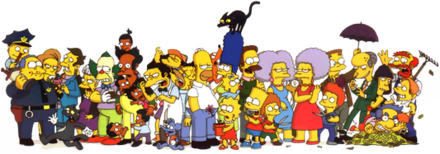 The show includes a vast array of quirky supporting characters, which include Homer's friends Barney Gumble, Lenny Leonard and Carl Carlson; the school principal Seymour Skinner and staff members such as Edna Krabappel and Groundskeeper Willie; students such as Milhouse Van Houten, Nelson Muntz and Ralph Wiggum; shopkeepers such as Apu Nahasapeemapetilon, Comic Book Guy and Moe Szyslak; government figures Mayor "Diamond" Joe Quimby and Clancy Wiggum; next-door neighbor Ned Flanders; local celebrities such as Krusty the Clown and news reporter Kent Brockman; nuclear tycoon Montgomery Burns and his devoted assistant Waylon Smithers; and dozens more. The creators originally intended many of these characters as one-time jokes or for fulfilling needed functions in the town. A number of them have gained expanded roles and subsequently starred in their own episodes. According to Matt Groening, the show adopted the concept of a large supporting cast from the comedy show SCTV.[14] Continuity and the floating timeline[edit]Despite the depiction of yearly milestones such as holidays or birthdays passing, the characters never age. The series uses a floating timeline in which episodes generally take place in the year the episode is produced. Flashbacks and flashforwards do occasionally depict the characters at other points in their lives, with the timeline of these depictions also generally floating relative to the year the episode is produced. For example, the 1991 episodes "The Way We Was" and "I Married Marge" depict Homer and Marge as high schoolers in the 1970s who had Bart (who is always 10 years old) in the early '80s, while the 2008 episode "That '90s Show" depicts Homer and Marge as a childless couple in the '90s, and the 2021 episode "Do Pizza Bots Dream of Electric Guitars" portrays Homer as an adolescent in the same period. The 1995 episode "Lisa's Wedding" takes place during Lisa's college years in the then-future year of 2010, the same year the show began airing its 22nd season, in which Lisa was still 8. Regarding the contradictory flashbacks, Selman stated that "they all kind of happened in their imaginary world."[15] The show follows a loose and inconsistent continuity. For example, Krusty the Clown may be able to read in one episode, but not in another. However, it is consistently portrayed that he is Jewish, that his father was a rabbi, and that his career began in the 1960s. The latter point introduces another snag in the floating timeline: historical periods that are a core part of a character's backstory remain so even when their age makes it unlikely or impossible, such as Grampa Simpson and Principal Skinner's respective service in World War II and Vietnam. The only episodes not part of the series' main canon are the Treehouse of Horror episodes, which often feature the deaths of main characters. Characters who die in "regular" episodes, such as Maude Flanders, Mona Simpson and Edna Krabappel, however, stay dead. Most episodes end with the status quo being restored, though occasionally major changes will stick, such as Lisa's conversions to vegetarianism and Buddhism, the divorce of Milhouse van Houten's parents, and the marriage and subsequent parenthood of Apu and Manjula. Setting[edit]The Simpsons takes place in a fictional American town called Springfield. Although there are many real settlements in America named Springfield,[16] the town the show is set in is fictional. The state it is in is not established. In fact, the show is intentionally evasive with regard to Springfield's location.[17] Springfield's geography and that of its surroundings is inconsistent: from one episode to another, it may have coastlines, deserts, vast farmland, mountains, or whatever the story or joke requires.[18] Groening has said that Springfield has much in common with Portland, Oregon, the city where he grew up.[19] Groening has said that he named it after Springfield, Oregon, and the fictitious Springfield which was the setting of the series Father Knows Best. He "figured out that Springfield was one of the most common names for a city in the U.S. In anticipation of the success of the show, I thought, 'This will be cool; everyone will think it's their Springfield.' And they do."[20] Many landmarks, including street names, have connections to Portland.[21] Production[edit]Development[edit]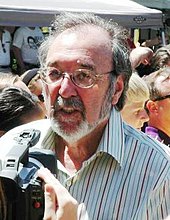 When producer James L. Brooks was working on the television variety show The Tracey Ullman Show, he decided to include small animated sketches before and after the commercial breaks. Having seen one of cartoonist Matt Groening's Life in Hell comic strips, Brooks asked Groening to pitch an idea for a series of animated shorts. Groening initially intended to present an animated version of his Life in Hell series.[22] However, Groening later realized that animating Life in Hell would require the rescinding of publication rights for his life's work. He therefore chose another approach while waiting in the lobby of Brooks's office for the pitch meeting, hurriedly formulating his version of a dysfunctional family that became the Simpsons.[22][23] He named the characters after his own family members, substituting "Bart" for his own name, adopting an anagram of the word brat.[22] The Simpson family first appeared as shorts in The Tracey Ullman Show on April 19, 1987.[24] Groening submitted only basic sketches to the animators and assumed that the figures would be cleaned up in production. However, the animators merely re-traced his drawings, which led to the crude appearance of the characters in the initial shorts.[22] The animation was produced domestically at Klasky Csupo,[25][26] with Wes Archer, David Silverman, and Bill Kopp being animators for the first season.[27] The colorist, "Georgie" Gyorgyi Kovacs Peluce (Kovács Györgyike)[28][29][30][31][32][33] made the characters yellow; as Bart, Lisa and Maggie have no hairlines, she felt they would look strange if they were flesh-colored. Groening supported the decision, saying: "Marge is yellow with blue hair? That's hilarious — let's do it!"[27] In 1989, a team of production companies adapted The Simpsons into a half-hour series for the Fox Broadcasting Company. The team included the Klasky Csupo animation house. Brooks negotiated a provision in the contract with the Fox network that prevented Fox from interfering with the show's content.[34] Groening said his goal in creating the show was to offer the audience an alternative to what he called "the mainstream trash" that they were watching.[35] The half-hour series premiered on December 17, 1989, with "Simpsons Roasting on an Open Fire".[36] "Some Enchanted Evening" was the first full-length episode produced, but it did not broadcast until May 1990, as the last episode of the first season, because of animation problems.[37] In 1992, Tracey Ullman filed a lawsuit against Fox, claiming that her show was the source of the series' success. The suit said she should receive a share of the profits of The Simpsons[38]—a claim rejected by the courts.[39] Executive producers and showrunners[edit] List of showrunners throughout the series' run:
Matt Groening and James L. Brooks have served as executive producers during the show's entire history, and also function as creative consultants. Sam Simon, described by former Simpsons director Brad Bird as "the unsung hero" of the show,[40] served as creative supervisor for the first four seasons. He was constantly at odds with Groening, Brooks and the show's production company Gracie Films and left in 1993.[41] Before leaving, he negotiated a deal that sees him receive a share of the profits every year, and an executive producer credit despite not having worked on the show since 1993,[41][42] at least until his passing in 2015.[43] A more involved position on the show is the showrunner, who acts as head writer and manages the show's production for an entire season.[27] Writing[edit]The first team of writers, assembled by Sam Simon, consisted of John Swartzwelder, Jon Vitti, George Meyer, Jeff Martin, Al Jean, Mike Reiss, Jay Kogen and Wallace Wolodarsky.[44] Newer Simpsons' writing teams typically consist of sixteen writers who propose episode ideas at the beginning of each December.[45] The main writer of each episode writes the first draft. Group rewriting sessions develop final scripts by adding or removing jokes, inserting scenes, and calling for re-readings of lines by the show's vocal performers.[46] Until 2004,[47] George Meyer, who had developed the show since the first season, was active in these sessions. According to long-time writer Jon Vitti, Meyer usually invented the best lines in a given episode, even though other writers may receive script credits.[46] Each episode takes six months to produce so the show rarely comments on current events.[48] 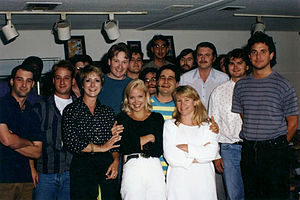 Credited with sixty episodes, John Swartzwelder is the most prolific writer on The Simpsons.[49] One of the best-known former writers is Conan O'Brien, who contributed to several episodes in the early 1990s before replacing David Letterman as host of the talk show Late Night.[50] English comedian Ricky Gervais wrote the episode "Homer Simpson, This Is Your Wife", becoming the first celebrity both to write and guest star in the same episode.[51] Seth Rogen and Evan Goldberg, writers of the film Superbad, wrote the episode "Homer the Whopper", with Rogen voicing a character in it.[52] At the end of 2007, the writers of The Simpsons went on strike together with the other members of the Writers Guild of America, East. The show's writers had joined the guild in 1998.[53] In May 2023, the writers of The Simpsons went on strike together with the other members of the Writers Guild of America, East.[54][55] Voice actors[edit] | ||||||||||||||||||||||||||||||||||||||||||||||||||
|---|---|---|---|---|---|---|---|---|---|---|---|---|---|---|---|---|---|---|---|---|---|---|---|---|---|---|---|---|---|---|---|---|---|---|---|---|---|---|---|---|---|---|---|---|---|---|---|---|---|---|---|---|---|---|---|---|


